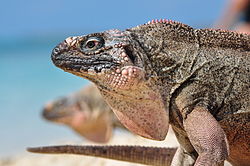- Cyclura cychlura inornata
-
Allen Cays Rock Iguana Cyclura cychlura inornata Conservation status Scientific classification Kingdom: Animalia Phylum: Chordata Class: Sauropsida Order: Squamata Family: Iguanidae Genus: Cyclura Species: C. cychlura' Subspecies: C. c. inornata Trinomial name Cyclura cychlura inornata
(Schwartz & Thomas, 1975)The Allen Cays Rock Iguana (Cyclura cychlura inornata) is an endangered subspecies of the Northern Bahamian Rock Iguana that is found on Allen Cay in the Bahamas. Its status is Endangered, with a wild population of 1,000 animals, and it can be found on the IUCN Red List.[1]
Contents
Taxonomy
The Allen Cays iguana, Cyclura cychlura inornata, is endemic to Leaf Cay and Southwest Allen's Cay in the northern Exuma Island chain in the Bahamas.[1] It is one of three subspecies of the Northern Bahamian Rock Iguana, the others being the Andros Island Iguana (Cyclura cychlura cychlura) and the Exuma Island Iguana (Cyclura cychlura figginsi).[1][2] Its generic name (Cyclura) is derived from the Ancient Greek cyclos (κύκλος) meaning "circular" and ourá (οὐρά) meaning "tail", after the thick-ringed tail characteristic of all Cyclura species.[3]
Anatomy and morphology
The Allen Cays iguana is a large rock iguana which attains a total length of close to 1.5 meters.[1] Its coloration is dark-gray to black, with yellowish green or orange tinged scales on the legs, dorsal crest, and the head. When the animal matures, the yellow coloration changes to a bright reddish orange color in contrast to the animals darker striped body and black feet.
Males of this species, like other species within the Genus Cyclura, are larger than females, and have more prominent dorsal crests in addition to prominent femoral pores on their thighs, which are used to release pheromones. Females have less prominent pores and have shorter crests than the males making the animals sexually dimorphic.[4][5]
Diet
Like all Cyclura species, the Allen Cays iguana is primarily herbivorous, consuming leaves, flowers and fruits from close to 13 different species of plant found on the cay.[6] This diet is supplemented by eating crustaceans such as crab and handouts from tourists from sandwiches to table scraps and whatever else tourists to the islands bring.[6] This has also caused the iguanas to lose their fear of humans and in some cases become aggressive.[6]
Mating
Mating occurs in May, and eggs are usually laid in June or July, in nests excavated within sandy soil on Leaf Cay and U Cay. Due to lack of sand on the honeycomb limestone beaches on Allen's Cay, iguanas have not bred there for many years.
Outside of the mating season, the iguanas have dominance hierarchies rather than strictly defended territories like cyclura from other islands.[6] This has been attributed to the regular food supply from tourists feeding the lizards on the beach causing a disruption in their social structure.[6]
Conservation
Endangered status
It is estimated that the current global population is less than 1,000 and is declining.[1]
Causes of decline
The biggest threat to the Allen Cays iguana is in the form of poaching.[1] The animals are hunted for food and captured for sale in the pet trade.[7]
Recovery efforts
Like all Bahamian rock iguanas, this species is protected in the Bahamas under the Wild Animals Protection Act of 1968.[1] However, no areas have been specifically designated for the protection of iguanas and no specific conservation programs are in place.[1]
There is currently a captive breeding program in place at the Ardastra Zoo.
References
- ^ a b c d e f g h i D. Blair & West Indian Iguana Specialist Group (2000). "Cyclura cychlura inornata". IUCN Red List of Threatened Species. Version 2009.2. International Union for Conservation of Nature. http://www.iucnredlist.org/apps/redlist/details/6041. Retrieved February 23, 2010.
- ^ Hollingsworth, Bradford D. (2004), "The Evolution of Iguanas: An Overview of Relationships and a Checklist of Species", Iguanas: Biology and Conservation (University of California Press): pp. 35–39, ISBN 9780520238541
- ^ Sanchez, Alejandro. "Family Iguanidae: Iguanas and Their Kin". Father Sanchez's Web Site of West Indian Natural History Diapsids I: Introduction; Lizards. Kingsnake.com. http://www.kingsnake.com/westindian/metazoa10.html. Retrieved November 26, 2007.
- ^ De Vosjoli, Phillipe; David Blair (1992), The Green Iguana Manual, Escondido, California: Advanced Vivarium Systems, ISBN 74886904040
- ^ Martins, Emilia P.; Lacy, Kathryn (2004), "Behavior and Ecology of Rock Iguanas,I: Evidence for an Appeasement Display", Iguanas: Biology and Conservation (University of California Press): pp. 98–108, ISBN 9780520238541
- ^ a b c d e Iverson, John; Smith, Geoffrey; Pieper, Lynne (2004), "Factors Affecting Long-Term Growth of the Allen Cays Rock Iguana in the Bahamas", Iguanas: Biology and Conservation (University of California Press): pp. 176, ISBN 9780520238541
- ^ Iverson, John (21 May 2003) (– Scholar search), Results of Allen Cays Iguana study (Cyclura cychlura inornata, Dept. of Biology, Earlham College, http://www.earlham.edu/~johni/Iguana.html[dead link]
External links
Iguanidae Kingdom: Animalia · Phylum: Chordata · Class: Sauropsida · Order: Squamata
Wikimedia Foundation. 2010.


